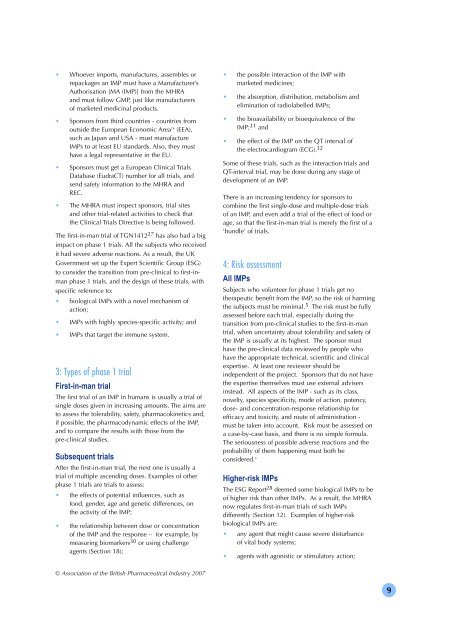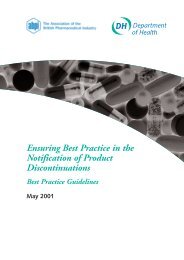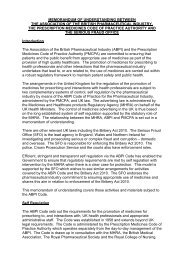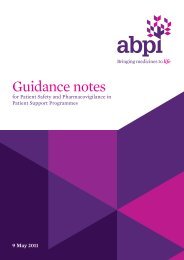ABPI Guidelines for Phase 1 Clinical Trials (PDF
ABPI Guidelines for Phase 1 Clinical Trials (PDF
ABPI Guidelines for Phase 1 Clinical Trials (PDF
Create successful ePaper yourself
Turn your PDF publications into a flip-book with our unique Google optimized e-Paper software.
• Whoever imports, manufactures, assembles or<br />
repackages an IMP must have a Manufacturer’s<br />
Authorisation [MA (IMP)] from the MHRA<br />
and must follow GMP, just like manufacturers<br />
of marketed medicinal products.<br />
• Sponsors from third countries - countries from<br />
outside the European Economic Area 26 (EEA),<br />
such as Japan and USA - must manufacture<br />
IMPs to at least EU standards. Also, they must<br />
have a legal representative in the EU.<br />
• Sponsors must get a European <strong>Clinical</strong> <strong>Trials</strong><br />
Database (EudraCT) number <strong>for</strong> all trials, and<br />
send safety in<strong>for</strong>mation to the MHRA and<br />
REC.<br />
• The MHRA must inspect sponsors, trial sites<br />
and other trial-related activities to check that<br />
the <strong>Clinical</strong> <strong>Trials</strong> Directive is being followed.<br />
The first-in-man trial of TGN1412 27 has also had a big<br />
impact on phase 1 trials. All the subjects who received<br />
it had severe adverse reactions. As a result, the UK<br />
Government set up the Expert Scientific Group (ESG)<br />
to consider the transition from pre-clinical to first-inman<br />
phase 1 trials, and the design of these trials, with<br />
specific reference to:<br />
• biological IMPs with a novel mechanism of<br />
action;<br />
• IMPs with highly species-specific activity; and<br />
• IMPs that target the immune system.<br />
3: Types of phase 1 trial<br />
First-in-man trial<br />
The first trial of an IMP in humans is usually a trial of<br />
single doses given in increasing amounts. The aims are<br />
to assess the tolerability, safety, pharmacokinetics and,<br />
if possible, the pharmacodynamic effects of the IMP,<br />
and to compare the results with those from the<br />
pre-clinical studies.<br />
Subsequent trials<br />
After the first-in-man trial, the next one is usually a<br />
trial of multiple ascending doses. Examples of other<br />
phase 1 trials are trials to assess:<br />
• the effects of potential influences, such as<br />
food, gender, age and genetic differences, on<br />
the activity of the IMP;<br />
• the relationship between dose or concentration<br />
of the IMP and the response – <strong>for</strong> example, by<br />
measuring biomarkers 30 or using challenge<br />
agents (Section 18);<br />
© Association of the British Pharmaceutical Industry 2007<br />
• the possible interaction of the IMP with<br />
marketed medicines;<br />
• the absorption, distribution, metabolism and<br />
elimination of radiolabelled IMPs;<br />
• the bioavailability or bioequivalence of the<br />
IMP; 31 and<br />
• the effect of the IMP on the QT interval of<br />
the electrocardiogram (ECG). 32<br />
Some of these trials, such as the interaction trials and<br />
QT-interval trial, may be done during any stage of<br />
development of an IMP.<br />
There is an increasing tendency <strong>for</strong> sponsors to<br />
combine the first single-dose and multiple-dose trials<br />
of an IMP, and even add a trial of the effect of food or<br />
age, so that the first-in-man trial is merely the first of a<br />
'bundle' of trials.<br />
4: Risk assessment<br />
All IMPs<br />
Subjects who volunteer <strong>for</strong> phase 1 trials get no<br />
therapeutic benefit from the IMP, so the risk of harming<br />
the subjects must be minimal. 5 The risk must be fully<br />
assessed be<strong>for</strong>e each trial, especially during the<br />
transition from pre-clinical studies to the first-in-man<br />
trial, when uncertainty about tolerability and safety of<br />
the IMP is usually at its highest. The sponsor must<br />
have the pre-clinical data reviewed by people who<br />
have the appropriate technical, scientific and clinical<br />
expertise. At least one reviewer should be<br />
independent of the project. Sponsors that do not have<br />
the expertise themselves must use external advisers<br />
instead. All aspects of the IMP - such as its class,<br />
novelty, species specificity, mode of action, potency,<br />
dose- and concentration-response relationship <strong>for</strong><br />
efficacy and toxicity, and route of administration -<br />
must be taken into account. Risk must be assessed on<br />
a case-by-case basis, and there is no simple <strong>for</strong>mula.<br />
The seriousness of possible adverse reactions and the<br />
probability of them happening must both be<br />
considered. 5<br />
Higher-risk IMPs<br />
The ESG Report 28 deemed some biological IMPs to be<br />
of higher risk than other IMPs. As a result, the MHRA<br />
now regulates first-in-man trials of such IMPs<br />
differently (Section 12). Examples of higher-risk<br />
biological IMPs are:<br />
• any agent that might cause severe disturbance<br />
of vital body systems;<br />
• agents with agonistic or stimulatory action;<br />
9









